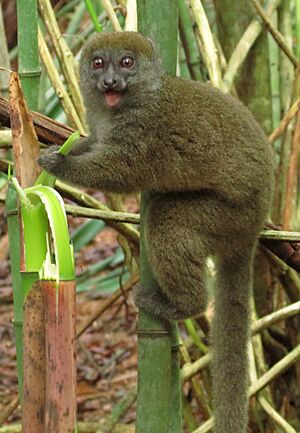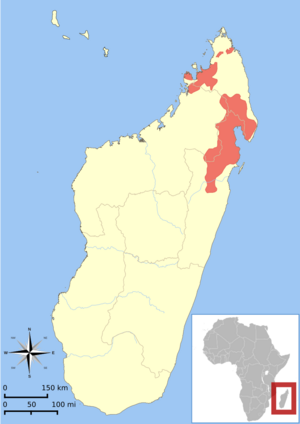Western lesser bamboo lemur facts for kids
Quick facts for kids Western lesser bamboo lemur |
|
|---|---|
 |
|
| Conservation status | |
| Scientific classification | |
 |
|
| Distribution of H. occidentalis |
The western lesser bamboo lemur is a special type of lemur that lives only on the island of Madagascar. It's also called the northern bamboo lemur or western gentle lemur. These cute animals are known for eating bamboo!
Contents
About the Western Lesser Bamboo Lemur
What Does It Look Like?
This lemur is a type of primate, like monkeys and apes. It grows to be about 55 to 67 centimeters (21 to 26 inches) long. More than half of that length is its tail! It usually weighs just under 1 kilogram (about 2.2 pounds).
Where Do They Live?
Western lesser bamboo lemurs live in different parts of northern and western Madagascar. You can find them in places like Ankarana and Analamerana in the north. They also live in the Sambirano area and the Ampasindava Peninsula in the northwest. In the west, they are found between the Mahavany and Tsiribihina Rivers.
These lemurs live in many protected areas. This includes eight national parks, two strict nature reserves, and eight special reserves. These special places help keep their homes safe.
What Do They Eat and How Do They Live?
These lemurs love to live in forests that have lots of bamboo and bamboo vines. They can even survive in small patches of bamboo surrounded by farms.
They usually live in small groups of about six lemurs. They are often active at night, looking for food. Their diet includes tasty fruits, liana flowers, and, of course, bamboo! They eat different kinds of bamboo, like giant bamboo.
Life Cycle and Reproduction
Female lemurs are pregnant for about 137 to 140 days. They usually give birth to one baby lemur. This often happens between October and January.
Protecting the Western Lesser Bamboo Lemur
Why Are They in Danger?
The western lesser bamboo lemur is considered a "vulnerable" species. This means they could become endangered if we don't protect them. They are also listed on Appendix 1 by CITES. This means it's illegal to trade them internationally.
One of the biggest problems for these lemurs is losing their homes. People sometimes burn forests to create land for farm animals. Making charcoal and mining in places like Ankarana also destroy their habitat. In some areas, like Makira, people hunt them using firearms and slingshots.
What's Being Done to Help?
Even if their habitat is a bit damaged, these lemurs can still survive if there's enough bamboo. There are also 18 western lesser bamboo lemurs living in European zoos. These zoos help protect the species and teach people about them.


